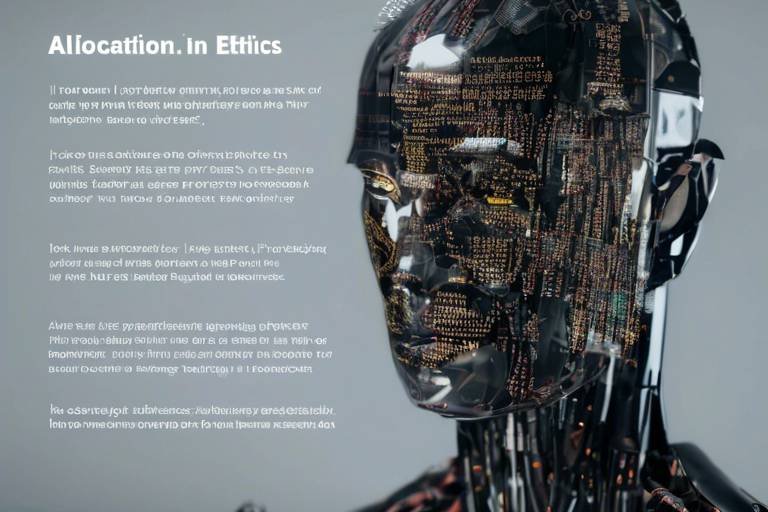Influencing AI Development through Ethics
In today's rapidly evolving technological landscape, the development of Artificial Intelligence (AI) has become a double-edged sword. On one hand, we have the potential for groundbreaking innovations that can transform industries and improve lives; on the other hand, we face significant ethical dilemmas that can arise from misuse or misunderstanding of these technologies. This article explores the importance of ethical considerations in AI development, outlining key principles, challenges, and strategies to ensure responsible innovation in technology.
Understanding the role of ethics in AI is crucial for guiding developers and organizations in creating technologies that respect human rights, promote fairness, and enhance societal welfare. Imagine a world where AI systems operate without ethical guidelines—chaos could ensue, leading to biased decision-making and a lack of accountability. Therefore, embedding ethical frameworks into AI development is not just a nice-to-have; it's a necessity. By prioritizing ethics, we can create a future where technology serves humanity rather than undermines it.
This section delves into fundamental ethical principles such as transparency, accountability, and fairness that should guide AI development and usage to mitigate potential harm. These principles act as the bedrock of responsible AI, ensuring that the technology is developed with a conscience. Let's explore these principles in detail.
Transparency is essential in AI systems to ensure users understand how decisions are made, fostering trust and enabling accountability in the technology's deployment. If you think about it, would you trust a black box that makes decisions affecting your life without knowing how it works? This is where transparency comes into play.
Effective communication of AI decision-making processes can help users grasp complex algorithms, leading to better acceptance and ethical use of AI technologies. For instance, if a healthcare AI suggests a treatment plan, the patient deserves to know how the AI reached that conclusion. By breaking down the decision-making process into understandable components, developers can demystify AI and build trust.
An open approach to AI development encourages collaboration and scrutiny, ultimately enhancing public trust in AI applications and their outcomes. When developers invite feedback and critique, they not only improve their systems but also create a culture of accountability.
Establishing accountability in AI development ensures that developers and organizations are responsible for the consequences of their technologies, promoting ethical practices throughout the lifecycle. Without accountability, developers might cut corners, leading to harmful outcomes. Just like a captain is responsible for their ship, AI developers must take ownership of their creations.
Despite the importance of ethics, various challenges hinder the effective implementation of ethical guidelines in AI development, including biases, lack of regulations, and technological complexities. Recognizing these challenges is the first step in addressing them.
Bias in AI can lead to unfair treatment and discrimination, making it imperative to identify and mitigate biases during the development process to ensure equitable outcomes. For example, if an AI system is trained on biased data, it will likely perpetuate those biases, leading to skewed results. Developers must be vigilant and proactive in auditing their data and algorithms.
The absence of comprehensive regulatory frameworks poses challenges for ethical AI development, emphasizing the need for policies that guide responsible practices and protect users. Without regulations, the wild west of AI can lead to unethical practices that could harm individuals and society at large.
Implementing effective strategies is vital for promoting ethical AI development, including stakeholder engagement, interdisciplinary collaboration, and continuous monitoring of AI systems. These strategies create a robust framework for ethical AI.
Involving diverse stakeholders in the AI development process ensures that multiple perspectives are considered, leading to more inclusive and ethical outcomes. Whether it's users, ethicists, or community leaders, engaging various voices enriches the development process.
Collaborating across disciplines can enhance ethical AI development by integrating insights from fields like philosophy, sociology, and law, fostering a comprehensive understanding of ethical implications. Just as a well-rounded education includes multiple subjects, ethical AI requires a multifaceted approach.
- What is the role of ethics in AI development?
Ethics guide developers in creating technologies that respect human rights and promote fairness. - How can transparency improve AI trust?
By clearly explaining how AI systems make decisions, users can better understand and trust these technologies. - What challenges exist in ethical AI implementation?
Challenges include biases, lack of regulatory frameworks, and technological complexities. - Why is stakeholder engagement important?
It ensures diverse perspectives are considered, leading to more inclusive and ethical outcomes.

The Importance of Ethics in AI
Understanding the role of ethics in AI is crucial for guiding developers and organizations in creating technologies that respect human rights, promote fairness, and enhance societal welfare. As we dive deeper into the digital age, the integration of artificial intelligence into our daily lives has become not just common but essential. With this rise, however, comes a significant responsibility to ensure that these technologies are developed and deployed in a manner that aligns with our core ethical values. Imagine a world where AI systems make decisions that could impact your life—everything from job applications to healthcare. Wouldn't you want to know that these systems are designed with fairness and transparency in mind?
Ethics in AI isn't just a buzzword; it's a necessary framework that shapes how these systems operate. By embedding ethical considerations into the development process, we can mitigate risks associated with bias, discrimination, and privacy violations. For instance, consider how an AI-driven hiring tool might inadvertently favor one demographic over another due to biased training data. Without ethical guidelines, such outcomes could perpetuate existing inequalities, leading to a society where technology reinforces rather than alleviates disparities.
Moreover, ethical AI development fosters trust among users. When people understand that the technology they interact with is designed with their best interests at heart, they are more likely to embrace it. This trust is built through transparency and accountability—two pillars of ethical AI practices. For example, if an AI system is transparent about its decision-making process, users can see how outcomes are derived, making them feel more secure in its use. This is particularly important in sensitive areas such as healthcare, finance, and law enforcement, where the stakes are incredibly high.
Incorporating ethics into AI development also encourages a culture of responsibility. Developers and organizations must recognize that their creations can have far-reaching consequences. By prioritizing ethical considerations, they can create systems that not only serve their intended purpose but also contribute positively to society. This proactive approach can lead to innovative solutions that enhance user experience while ensuring that ethical standards are upheld.
As we move forward, it is imperative that ethical frameworks evolve alongside technological advancements. Continuous dialogue among stakeholders—developers, users, ethicists, and policymakers—is essential to navigate the complexities of AI. By engaging in open discussions, we can better understand the implications of AI technologies and work collaboratively towards solutions that prioritize human dignity and societal welfare.
In conclusion, the importance of ethics in AI cannot be overstated. It serves as the compass guiding us through the uncharted waters of technological innovation. By embedding ethical principles into the fabric of AI development, we can ensure that these powerful tools enhance our lives rather than detract from them. The future of AI should be one where technology and ethics go hand in hand, creating a world that is not only smarter but also fairer.
- What are the key ethical principles in AI? The key principles include transparency, accountability, fairness, and respect for human rights.
- How can bias be addressed in AI systems? Bias can be mitigated by using diverse training data, conducting regular audits, and involving multiple stakeholders in the development process.
- Why is transparency important in AI? Transparency helps users understand how decisions are made, fostering trust and enabling accountability.
- What role do regulations play in ethical AI development? Regulations provide guidelines that help ensure responsible practices and protect users from potential harms.

Key Ethical Principles
The development of artificial intelligence (AI) is not just about creating smarter algorithms or more efficient machines; it's about ensuring that these technologies are built on a foundation of strong ethical principles. These principles serve as a guiding light for developers and organizations, ensuring that the innovations they create are not only effective but also responsible and fair. Among the key ethical principles that should be embraced in AI development are transparency, accountability, and fairness. Each of these principles plays a crucial role in shaping how AI technologies are perceived and utilized in our society.
Transparency is perhaps one of the most critical aspects of ethical AI. When users understand how an AI system makes decisions, it fosters trust and allows for more informed interactions with the technology. Imagine using a navigation app that not only tells you the fastest route but also explains why that route is chosen—this level of transparency can significantly enhance user confidence. To further illustrate this point, let’s consider a table that outlines the importance of transparency in AI systems:
| Aspect | Importance |
|---|---|
| User Trust | Understanding decision-making processes builds confidence in AI applications. |
| Accountability | Transparency allows for scrutiny and holds developers accountable for their systems. |
| Improved Outcomes | Clear insights into AI operations can lead to better user experiences and outcomes. |
Another vital principle is accountability. It’s not enough for developers to create advanced AI systems; they must also be held responsible for the consequences of their technologies. This involves establishing clear lines of accountability within organizations, ensuring that there are processes in place to address any issues that arise from the deployment of AI. For instance, if an AI system makes a biased decision, it’s essential to trace back the steps to identify where the fault lies and rectify it. This is akin to a ship captain being responsible for their crew’s safety; accountability in AI development ensures that the creators of these systems are also responsible for their impact on society.
Lastly, the principle of fairness cannot be overlooked. Fairness in AI involves ensuring that the technologies do not discriminate against any group or individual. This principle is particularly important in areas such as hiring practices, law enforcement, and lending, where biased algorithms can lead to significant societal harm. Developers should actively work to identify and mitigate biases in their AI systems. This process can involve using diverse datasets, conducting regular audits, and engaging with communities that may be affected by AI decisions. By prioritizing fairness, developers can help create a more equitable society where technology serves all individuals justly.
In summary, the key ethical principles of transparency, accountability, and fairness are essential for guiding the responsible development of AI technologies. By embedding these principles into the fabric of AI development, we can ensure that these powerful tools enhance rather than undermine our societal values.
- What is the importance of ethics in AI development?
Ethics in AI development is crucial to ensure that technologies respect human rights, promote fairness, and enhance societal welfare. - How can transparency be achieved in AI systems?
Transparency can be achieved by clearly communicating how AI systems make decisions, which helps build trust and accountability. - What role does accountability play in AI?
Accountability ensures that developers and organizations are responsible for the outcomes of their AI technologies, promoting ethical practices. - How can bias in AI be addressed?
Bias can be addressed by identifying and mitigating biases during the development process, ensuring equitable outcomes for all users.

Transparency in AI Systems
Transparency in AI systems is not just a buzzword; it’s a fundamental pillar that supports the entire structure of ethical AI development. When we talk about transparency, we’re essentially referring to the clarity and openness with which AI systems operate. Imagine trying to navigate a complex maze without a map; that’s how users feel when they don’t understand how AI makes decisions. By ensuring that AI systems are transparent, we empower users to comprehend the underlying processes that drive these technologies. This understanding is crucial as it fosters trust between users and AI systems, making them more likely to accept and utilize these innovations.
Moreover, transparency plays a critical role in enabling accountability. When users can see how decisions are made, they are more equipped to hold developers and organizations responsible for the outcomes produced by AI systems. This is particularly important in sensitive areas such as healthcare, criminal justice, and hiring, where the stakes are incredibly high. For instance, if an AI system denies a loan application, users deserve to know the rationale behind that decision. Was it based on historical data that might reflect biases? Or was it a fair assessment of creditworthiness? Without transparency, users are left in the dark, which can lead to mistrust and skepticism.
To illustrate the importance of transparency, let's consider a few key aspects:
- Explainability: AI systems should be able to provide clear explanations for their decisions. This means that complex algorithms must be simplified enough for users to grasp. When AI can articulate its reasoning, it demystifies the technology and encourages user engagement.
- Documentation: Comprehensive documentation of AI systems is essential. This includes not only the algorithms used but also the data sources, training processes, and potential limitations. Detailed records help users and developers alike to understand the system's capabilities and constraints.
- User Control: Giving users some control over AI systems can enhance transparency. For example, allowing users to adjust parameters or provide feedback can create a sense of ownership and understanding.
Building trust through transparency is a continuous journey. Developers need to adopt an open approach, inviting collaboration and scrutiny from stakeholders, including users, policymakers, and ethicists. This collaborative environment not only improves the quality of AI systems but also enhances public trust in their applications and outcomes. Think of it this way: just as a well-lit room feels more welcoming and safe, a transparent AI system fosters a sense of security and confidence among its users.
In conclusion, transparency in AI systems is not merely an ethical requirement; it is a practical necessity that enhances user trust, accountability, and overall effectiveness. By prioritizing transparency, we can pave the way for more responsible and ethical AI development, ultimately benefiting society as a whole.
- What is transparency in AI? Transparency in AI refers to the clarity and openness regarding how AI systems operate and make decisions.
- Why is transparency important in AI? It fosters trust, enables accountability, and helps users understand the decision-making processes of AI systems.
- How can AI systems be made more transparent? By providing clear explanations, comprehensive documentation, and allowing user control over the systems.

Explaining AI Decision-Making
Understanding how AI systems make decisions is akin to peering into a black box filled with intricate gears and levers. When we talk about AI decision-making, we are referring to the processes and algorithms that enable machines to analyze data and draw conclusions. This can often seem mysterious to the average user, and that's where the importance of clear communication comes into play. By demystifying these processes, we can foster a sense of trust and acceptance among users, which is crucial for the widespread adoption of AI technologies.
At the heart of AI decision-making lies a combination of data analysis, machine learning algorithms, and predictive modeling. Let's break this down:
- Data Analysis: AI systems process vast amounts of data to identify patterns and correlations. This data could range from user behavior to environmental factors, all contributing to the decision-making process.
- Machine Learning Algorithms: These algorithms are designed to learn from data, improving their accuracy over time. For example, a recommendation system on a streaming platform learns your preferences based on what you watch.
- Predictive Modeling: This involves using historical data to predict future outcomes. A classic example is how AI can forecast sales trends based on past performance, helping businesses make informed decisions.
However, simply knowing that AI uses data and algorithms is not enough. Users need to understand how these elements interact to produce decisions. For instance, if an AI system denies a loan application, users should be able to see the factors that influenced this decision, such as credit score, income level, and other relevant data points. This transparency can help users feel more confident that the system is operating fairly and not arbitrarily.
Moreover, effective communication of AI decision-making processes can also lead to better user engagement. When users feel informed about how their data is being used and how decisions are made, they are more likely to trust the technology. This trust is essential, especially when AI systems are deployed in sensitive areas such as healthcare, finance, and criminal justice, where the stakes are incredibly high.
In conclusion, explaining AI decision-making is not just about technical jargon; it's about creating a bridge of understanding between technology and users. By illuminating how decisions are made, we can promote ethical use and foster a collaborative environment where AI can thrive responsibly.
- What is AI decision-making?
AI decision-making refers to the processes and algorithms that enable artificial intelligence systems to analyze data and draw conclusions. - Why is transparency important in AI?
Transparency helps users understand how decisions are made, fostering trust and accountability in AI technologies. - How can users be informed about AI decisions?
Effective communication strategies, such as clear explanations and visualizations of data processes, can help users grasp AI decision-making.

Building Trust through Openness
In today's fast-paced technological landscape, where artificial intelligence (AI) is becoming an integral part of our daily lives, building trust through openness is more critical than ever. Imagine walking into a room filled with strangers; the more transparent they are about their intentions and backgrounds, the more comfortable you feel. The same principle applies to AI technologies. When developers are open about how AI systems work, it fosters a sense of trust and security among users. This transparency can be achieved in various ways, such as sharing algorithms, data sources, and decision-making processes.
One effective approach to enhancing transparency is through the use of explainable AI (XAI). This concept revolves around making AI systems understandable to non-experts. By providing clear explanations of how decisions are made, users can better grasp the complexities behind the technology. This not only leads to better acceptance but also encourages ethical use. For instance, if an AI system denies a loan application, a clear explanation of the factors involved can help the applicant understand the reasoning behind the decision, reducing feelings of unfairness or discrimination.
Moreover, adopting an open-source model can significantly contribute to trust-building. When AI developers share their code and methodologies, it allows for community scrutiny and collaboration. This openness can lead to improved algorithms and more robust systems, as diverse perspectives come together to identify potential flaws or biases. The result is a more reliable technology that users can trust. In fact, many successful AI projects today leverage open-source principles, demonstrating that collaboration can lead to better outcomes for everyone involved.
However, it's essential to recognize that transparency doesn't mean revealing sensitive information that could compromise user privacy or security. Striking the right balance between openness and confidentiality is crucial. Developers should prioritize ethical considerations, ensuring that while the workings of AI systems are accessible, user data remains protected. This dual commitment to transparency and privacy can significantly enhance public trust.
Ultimately, building trust through openness is not just about sharing information; it's about creating a culture of accountability and responsibility. When developers are transparent about their processes, they signal to users that they are committed to ethical practices. This culture can be further strengthened by establishing clear channels for feedback, allowing users to voice their concerns and suggestions. By actively engaging with users and addressing their needs, organizations can foster a sense of partnership, leading to a more positive perception of AI technologies.
- What is the importance of transparency in AI? Transparency in AI helps users understand how decisions are made, fostering trust and enabling accountability.
- How can explainable AI improve user acceptance? Explainable AI provides clear reasoning behind decisions, allowing users to comprehend complex algorithms.
- What role does open-source play in building trust? Open-source models promote collaboration and scrutiny, leading to improved algorithms and more reliable systems.
- How can developers balance transparency and user privacy? Developers should share information about AI processes while ensuring that sensitive user data remains protected.

Accountability in AI Development
Accountability in AI development is not just a buzzword; it's a **necessary principle** that ensures developers and organizations take responsibility for the technologies they create. In a world where AI systems can significantly influence our daily lives—from the way we shop to how we receive medical care—it's essential that those who design and deploy these systems are held accountable for their actions. This accountability creates a framework where ethical practices are not merely suggested but are actively enforced, leading to a more trustworthy technological landscape.
Consider this: when a self-driving car makes a mistake, who is responsible? Is it the manufacturer, the software developer, or the data provider? This ambiguity can lead to a lack of trust in AI technologies. Establishing clear lines of accountability helps to clarify these roles and ensures that there is a **mechanism for redress** when things go wrong. By defining who is responsible for what, we can promote ethical practices that prioritize user safety and societal welfare.
To effectively implement accountability in AI development, organizations can adopt several strategies:
- Clear Documentation: Maintaining thorough records of the development process, including decision-making rationale, can help trace back actions taken during AI system creation.
- Regular Audits: Conducting periodic assessments of AI systems can identify potential ethical issues or biases that may have been overlooked during development.
- Feedback Mechanisms: Implementing channels for user feedback allows developers to understand the impact of their technologies and make necessary adjustments.
Moreover, accountability should extend beyond just the developers and organizations. It also involves engaging with users and stakeholders to ensure that their voices are heard in the development process. By fostering a culture of **shared responsibility**, where everyone involved—developers, organizations, users, and regulators—plays a role in ethical AI development, we can create systems that are not only effective but also equitable.
In summary, accountability in AI development is crucial for ensuring that technologies serve the public good. By establishing clear lines of responsibility, promoting transparency, and engaging stakeholders, we can build trust in AI systems and ensure that they are developed and deployed ethically. The journey toward responsible AI is ongoing, but with accountability at the forefront, we can navigate the challenges ahead with confidence.
- What is accountability in AI development? Accountability in AI development refers to the responsibility that developers and organizations have for the outcomes of their AI systems, ensuring they act ethically and transparently.
- Why is accountability important? It is crucial because it builds trust in AI technologies, clarifies responsibility, and promotes ethical practices that prioritize user safety and societal welfare.
- How can organizations ensure accountability? Organizations can ensure accountability through clear documentation, regular audits, and by implementing feedback mechanisms that involve users and stakeholders.

Challenges in Ethical AI Implementation
Despite the increasing recognition of the importance of ethics in AI, there are significant challenges that hinder the effective implementation of ethical guidelines. One of the most pressing issues is the presence of bias in AI systems. Bias can manifest in various forms, such as data bias, algorithmic bias, and societal bias, leading to unfair treatment of certain groups. For instance, if an AI model is trained on historical data that reflects existing inequalities, it may inadvertently perpetuate those biases in its decision-making processes. This scenario raises a critical question: how can developers ensure that their AI systems promote fairness and do not discriminate against marginalized communities?
Another notable challenge is the lack of comprehensive regulations surrounding AI development. In the absence of robust frameworks, organizations may prioritize profit over ethical considerations, resulting in technologies that could harm individuals or society at large. The rapid pace of AI innovation often outstrips the ability of policymakers to create effective regulations, leading to a regulatory lag. This situation calls for a concerted effort to establish clear guidelines that not only protect users but also hold developers accountable for their creations.
Technological complexities also play a significant role in the challenges of ethical AI implementation. The intricate nature of AI algorithms can make it difficult for developers to understand how decisions are made. This lack of understanding can result in a phenomenon known as the "black box" problem, where users and even developers cannot explain why an AI system made a particular decision. This opacity can erode trust and hinder the ethical deployment of AI technologies. To tackle this issue, it is crucial to develop methods that enhance the transparency of AI systems, allowing stakeholders to comprehend and scrutinize the decision-making processes involved.
Ultimately, addressing these challenges requires a multi-faceted approach. Engaging diverse stakeholders, including ethicists, technologists, and affected communities, can provide valuable insights into the ethical implications of AI technologies. By fostering interdisciplinary collaboration, we can create a more comprehensive understanding of the ethical landscape and develop solutions that prioritize societal welfare. Moreover, continuous monitoring of AI systems is essential to identify and rectify ethical concerns as they arise, ensuring that these technologies evolve responsibly.
- What are the main challenges in implementing ethical AI? The main challenges include bias in AI systems, lack of comprehensive regulations, and technological complexities that obscure understanding of AI decision-making.
- How can bias in AI be addressed? Bias can be mitigated by ensuring diverse training data, conducting regular audits, and involving stakeholders from various backgrounds in the development process.
- Why is transparency important in AI? Transparency fosters trust and accountability, allowing users to understand how AI systems make decisions and ensuring ethical usage of technology.

Addressing Bias in AI
Bias in Artificial Intelligence (AI) is a pressing concern that can lead to unfair treatment and discrimination across various sectors, including hiring, law enforcement, and healthcare. It's like a hidden trap; if developers aren’t vigilant, AI systems can perpetuate and even amplify existing societal biases. Imagine a world where the technology meant to assist us instead deepens divides—it's a scenario we must avoid at all costs.
To effectively address bias in AI, we first need to identify its sources. Bias often creeps in through the data used to train AI models. If the training data reflects historical inequalities or lacks diversity, the AI will likely mirror those biases in its outputs. For instance, if a hiring algorithm is trained on data from a company that predominantly hires one demographic, it may unfairly disadvantage candidates from other backgrounds. To combat this, developers should prioritize diverse data sets that accurately represent the population.
Moreover, it's essential to implement rigorous testing procedures. Regular audits of AI systems can help identify and rectify biases before they cause harm. This process involves analyzing the AI’s decisions and ensuring they align with ethical standards. Developers should ask themselves: Are the results fair? Do they uphold the principles of equality? By continuously monitoring AI systems, we can catch biases early and make necessary adjustments.
Another effective strategy is fostering a culture of diversity and inclusion within development teams. When people from different backgrounds collaborate, they bring unique perspectives that can highlight potential biases that others may overlook. This collaborative environment encourages open dialogue about ethical implications and helps create AI solutions that are more equitable. It’s like cooking a meal; the more diverse the ingredients, the richer the flavor!
Lastly, engaging with external stakeholders, including ethicists, community representatives, and affected individuals, can provide valuable insights into the impact of AI systems. These conversations can reveal biases that developers might not have considered, leading to more informed and ethical AI practices. In essence, addressing bias in AI requires a multifaceted approach that combines diverse data, rigorous testing, inclusive teams, and stakeholder engagement.
- What is bias in AI? Bias in AI refers to systematic favoritism or discrimination that occurs when AI systems produce results that are prejudiced due to flawed training data or algorithms.
- How can we identify bias in AI systems? Bias can be identified through auditing AI outputs, analyzing decision-making processes, and ensuring the training data reflects a diverse population.
- Why is diversity important in AI development? Diversity in development teams leads to a richer understanding of societal issues and helps in creating more equitable AI solutions.
- What role do stakeholders play in addressing bias? Stakeholders provide insights and perspectives that can highlight potential biases, ensuring that AI systems are fair and responsible.

Regulatory Frameworks for AI
In today's rapidly evolving technological landscape, the need for regulatory frameworks for artificial intelligence (AI) has never been more pressing. As AI systems become increasingly integral to various sectors—ranging from healthcare to finance—the absence of clear regulations can lead to significant risks. Unregulated AI can result in unintended consequences, including biased decision-making, privacy violations, and even security threats. Thus, establishing robust frameworks is essential to ensure that AI technologies are developed and deployed responsibly.
One of the primary challenges in creating these frameworks is the pace of technological advancement. Regulations often lag behind innovations, leaving a gap that can be exploited. For instance, while AI can analyze vast amounts of data to provide insights, it can also inadvertently perpetuate existing biases if not carefully monitored. This underscores the necessity for regulations that are not only comprehensive but also adaptable to the rapidly changing AI landscape.
Furthermore, regulatory frameworks must be designed with a focus on user protection and public safety. This involves setting clear guidelines that dictate how AI systems should function, ensuring that they operate transparently and fairly. For example, regulations could mandate that AI developers conduct thorough impact assessments before deploying their systems, evaluating potential risks and societal implications.
To illustrate the importance of regulatory frameworks, consider the following table, which highlights key components that these frameworks should encompass:
| Component | Description |
|---|---|
| Transparency | Ensuring that AI decision-making processes are clear and understandable to users. |
| Accountability | Establishing who is responsible for the outcomes of AI systems and their decisions. |
| Ethical Guidelines | Creating standards that prioritize fairness, privacy, and user rights in AI development. |
| Continuous Monitoring | Implementing ongoing assessments of AI systems to ensure compliance with regulations. |
Moreover, international collaboration is vital in shaping these frameworks. AI is a global phenomenon, and its implications do not recognize borders. By fostering collaboration among nations, we can develop unified standards that promote ethical AI practices worldwide. This could involve sharing best practices, conducting joint research, and establishing international regulatory bodies dedicated to overseeing AI development.
In conclusion, while the journey toward effective regulatory frameworks for AI is fraught with challenges, it is a necessary endeavor. By prioritizing transparency, accountability, and ethical guidelines, we can pave the way for AI technologies that not only enhance our lives but also uphold our fundamental rights and values. The future of AI should be one where innovation coexists harmoniously with ethical responsibility, ensuring that technology serves humanity rather than undermining it.
- Why are regulatory frameworks important for AI?
Regulatory frameworks ensure that AI technologies are developed and used responsibly, protecting users from potential harm and ensuring ethical practices. - What are the main challenges in implementing AI regulations?
The main challenges include the rapid pace of technological change, potential biases in AI systems, and the need for international collaboration. - How can stakeholders contribute to the development of AI regulations?
Stakeholders can provide valuable insights and perspectives, ensuring that regulations are comprehensive and address the needs of diverse communities.

Strategies for Ethical AI Development
In the rapidly evolving landscape of artificial intelligence, implementing effective strategies is not just beneficial but essential for ensuring that AI technologies are developed responsibly. This involves a multifaceted approach that incorporates various stakeholders, promotes interdisciplinary collaboration, and emphasizes the need for continuous monitoring of AI systems. By engaging diverse perspectives, organizations can navigate the complex ethical terrain of AI development, ensuring that the outcomes are not only innovative but also equitable and just.
One of the primary strategies involves engaging stakeholders from different backgrounds, including technologists, ethicists, policymakers, and the communities affected by AI systems. This engagement is crucial because it ensures that multiple viewpoints are considered during the development process. When stakeholders from various fields come together, they can identify potential ethical dilemmas and address them before they become problematic. For instance, a developer working on a facial recognition system may not fully grasp the social implications of their work unless they consult with sociologists or civil rights advocates. This collaborative approach not only enhances the ethical integrity of the AI solution but also fosters a sense of shared responsibility among all parties involved.
Furthermore, interdisciplinary collaboration plays a pivotal role in ethical AI development. By integrating insights from diverse fields such as philosophy, sociology, and law, developers can cultivate a more comprehensive understanding of the ethical implications of their technologies. For example, philosophers can contribute valuable ethical frameworks that guide decision-making processes, while legal experts can help navigate the regulatory landscape surrounding AI. This blend of expertise can lead to the development of AI systems that are not only technically sound but also socially responsible.
Continuous monitoring of AI systems is another critical strategy. Once AI technologies are deployed, it is vital to regularly assess their impact on users and society at large. This ongoing evaluation can help identify any unintended consequences or biases that may arise post-deployment. Organizations should establish feedback loops that allow users to report issues and provide insights into their experiences with AI systems. By actively listening to users and adapting systems accordingly, developers can ensure that their technologies remain aligned with ethical standards and societal expectations.
To summarize, the strategies for ethical AI development hinge on three core principles: stakeholder engagement, interdisciplinary collaboration, and continuous monitoring. By embracing these strategies, organizations can pave the way for responsible innovation in AI, ultimately leading to technologies that enhance human welfare and respect individual rights. As we move forward, it is crucial to remember that the future of AI is not just about technological advancement; it is also about the ethical implications of those advancements and their impact on society.
- What is ethical AI development? Ethical AI development refers to the process of creating AI technologies that are designed with consideration for moral principles, human rights, and societal welfare.
- Why is stakeholder engagement important in AI? Engaging stakeholders ensures that diverse perspectives are considered, leading to more inclusive and ethical outcomes in AI development.
- How can interdisciplinary collaboration enhance AI ethics? By bringing together insights from various fields, interdisciplinary collaboration fosters a comprehensive understanding of the ethical implications of AI technologies.
- What role does continuous monitoring play in ethical AI? Continuous monitoring allows organizations to assess the impact of AI systems post-deployment, helping to identify and address any unintended consequences or biases.

Engaging Stakeholders
Engaging stakeholders in the development of artificial intelligence (AI) is not just a best practice; it's a necessity. Think of it like constructing a building: you wouldn’t want to build a skyscraper without consulting architects, engineers, and even the community that will live around it. Similarly, when we develop AI technologies, we must consider the voices of various stakeholders to ensure that the end product is not only effective but also ethical and beneficial for society as a whole.
Stakeholder engagement involves a diverse group of individuals and organizations, including developers, users, policymakers, ethicists, and community representatives. Each of these groups brings unique perspectives and insights that can significantly influence the design, implementation, and impact of AI systems. For instance, developers can provide technical expertise, while ethicists can highlight potential moral dilemmas. By fostering an inclusive dialogue, we can create AI solutions that are more aligned with societal values.
Moreover, engaging stakeholders helps to identify and mitigate risks associated with AI technologies. When stakeholders are involved early in the development process, potential biases and ethical concerns can be addressed proactively. This approach not only enhances the quality of the AI system but also builds a sense of ownership and trust among users. When people feel their opinions matter, they are more likely to embrace and support the technology.
To effectively engage stakeholders, organizations can adopt several strategies:
- Workshops and Forums: Hosting workshops and forums can provide a platform for stakeholders to share their insights and concerns, fostering a collaborative environment.
- Surveys and Feedback Mechanisms: Utilizing surveys can help gather quantitative data on stakeholder opinions, while feedback mechanisms can allow for ongoing dialogue.
- Partnerships with Advocacy Groups: Collaborating with advocacy groups can ensure that marginalized voices are heard, promoting inclusivity in AI development.
In conclusion, engaging stakeholders is crucial for the ethical development of AI. By embracing a collaborative approach, we can harness diverse perspectives that lead to innovative solutions, ultimately ensuring that AI serves the greater good. Just like a well-constructed building stands tall and strong, an AI system built on stakeholder engagement will be robust, trustworthy, and beneficial for all.
Q1: Why is stakeholder engagement important in AI development?
A1: Stakeholder engagement is vital because it incorporates diverse perspectives, helps identify potential biases, and fosters trust in AI technologies. It ensures that the developed systems align with societal values and ethical standards.
Q2: Who are considered stakeholders in AI development?
A2: Stakeholders can include developers, users, policymakers, ethicists, community representatives, and advocacy groups. Each group contributes valuable insights that enhance the ethical and practical aspects of AI technologies.
Q3: What are effective ways to engage stakeholders?
A3: Effective engagement can be achieved through workshops, surveys, feedback mechanisms, and partnerships with advocacy groups. These methods promote dialogue and ensure that multiple perspectives are considered.

Interdisciplinary Collaboration
In the rapidly evolving landscape of artificial intelligence, has emerged as a critical component in fostering ethical development. Imagine a puzzle where each piece represents a different field of knowledge—when these pieces come together, they create a comprehensive picture that is essential for understanding the multifaceted implications of AI technologies. By integrating insights from various disciplines, such as philosophy, sociology, and law, we can cultivate a more nuanced approach to ethical AI.
For instance, philosophers can provide frameworks for understanding moral implications and ethical dilemmas posed by AI systems. They help us grapple with questions like, “What does it mean for an AI to be fair?” or “How do we define responsibility in automated decision-making?” Meanwhile, sociologists can shed light on the societal impacts of AI, examining how these technologies affect different communities and social structures. They can help identify potential disparities and advocate for marginalized voices, ensuring that the development process is inclusive.
Moreover, legal experts play a crucial role in shaping the regulatory landscape surrounding AI. They can help draft policies that not only protect users but also hold developers accountable for the consequences of their technologies. This collaboration across disciplines is not merely beneficial; it is essential in ensuring that AI serves the greater good while minimizing harm.
To illustrate the importance of this collaboration, consider the following table that outlines the contributions of different disciplines in AI development:
| Discipline | Contributions to AI Ethics |
|---|---|
| Philosophy | Frameworks for moral reasoning and ethical dilemmas |
| Sociology | Analysis of societal impacts and community engagement |
| Law | Development of regulations and accountability measures |
| Computer Science | Technical expertise in AI algorithms and systems |
| Psychology | Understanding human behavior and interaction with AI |
By fostering an environment where these diverse fields can collaborate, we create a robust framework for addressing the ethical challenges posed by AI. This approach not only enhances the development process but also ensures that the resulting technologies are aligned with societal values and ethical standards. As we continue to innovate, let’s remember that the best solutions often arise from the intersection of different perspectives, leading to a more holistic understanding of the implications of AI.
- What is interdisciplinary collaboration in AI?
It refers to the cooperation between various fields such as philosophy, sociology, law, and computer science to address the ethical implications of AI development.
- Why is it important for AI developers to engage with multiple disciplines?
Engaging with multiple disciplines helps ensure that diverse perspectives are considered, leading to more ethical and inclusive AI technologies.
- How can interdisciplinary collaboration improve AI ethics?
By combining insights from different fields, we can better understand the moral, social, and legal implications of AI, ultimately fostering responsible innovation.
Frequently Asked Questions
- What is the importance of ethics in AI development?
Ethics in AI development is crucial because it guides developers in creating technologies that respect human rights and promote fairness. By embedding ethical considerations into the design and deployment of AI systems, we can enhance societal welfare and ensure that these technologies benefit everyone, not just a select few.
- What are the key ethical principles in AI?
The key ethical principles in AI include transparency, accountability, and fairness. Transparency ensures that users understand how AI systems make decisions, accountability holds developers responsible for the outcomes of their technologies, and fairness aims to prevent discrimination and bias in AI applications.
- How does transparency affect AI systems?
Transparency affects AI systems by fostering trust among users. When people understand how decisions are made, they are more likely to accept and use AI technologies. This openness also encourages accountability, as it allows for scrutiny and collaboration in the development process.
- What challenges exist in implementing ethical AI?
Several challenges hinder the implementation of ethical AI, including the presence of biases in algorithms, a lack of regulatory frameworks, and the complexities of technology itself. These obstacles can lead to unfair treatment and hinder the responsible development of AI systems.
- How can biases in AI be addressed?
Biases in AI can be addressed by identifying and mitigating them during the development process. This involves careful data selection, ongoing testing, and incorporating diverse perspectives to ensure that AI systems produce equitable outcomes for all users.
- What role do stakeholders play in ethical AI development?
Stakeholders play a vital role in ethical AI development by providing diverse perspectives that can lead to more inclusive and responsible outcomes. Engaging various groups, including users, developers, and ethicists, ensures that multiple viewpoints are considered in the design and implementation of AI systems.
- Why is interdisciplinary collaboration important in AI?
Interdisciplinary collaboration is important in AI because it brings together insights from various fields, such as philosophy, sociology, and law. This comprehensive approach helps to better understand the ethical implications of AI technologies and promotes responsible innovation.



















